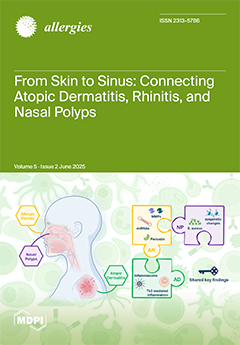Introduction: Allergic rhinitis (AR) is largely driven by IgE-induced immune cell activation, which promotes allergen-induced upper airway inflammation. The regulatory mechanisms of IgE synthesis in AR are poorly understood. Several analyses associate single nucleotide polymorphisms (SNPs) which reduce the expression of the
D2HGDH
[...] Read more.
Introduction: Allergic rhinitis (AR) is largely driven by IgE-induced immune cell activation, which promotes allergen-induced upper airway inflammation. The regulatory mechanisms of IgE synthesis in AR are poorly understood. Several analyses associate single nucleotide polymorphisms (SNPs) which reduce the expression of the
D2HGDH gene with AR.
D2HGDH encodes an enzyme that converts D-2-hydroxyglutarate (D2HG) to α-ketoglutarate (α-KG). This study aims to clarify the relationship between AR and SNPs in
D2HGDH. Methods: Mice were treated with vehicle control or octyl-D2HG prior to intranasal exposure to
Alternaria alternata. Draining lymph nodes (dLNs) were then evaluated for IgE-producing cells and T-cell polarization. Next, mice were exposed to intranasal Alternaria on days 0, 10, 20, and 27–30 and were treated intranasally with octyl-D2HG or vehicle control on days 20 and 27. Nasal inflammation was analyzed in nasal lavage fluid (NLF) cellularity and antigen-specific IgE production. Results: The administration of D2HG prior to Alternaria exposure suppressed IgE synthesis (
p < 0.01) and Th2 cell polarization (
p < 0.01) in dLNs. In a murine model of AR, D2HG administration reduced overall cellular infiltrates and eosinophils in NLF. Further, antigen-specific IgE in NLF was significantly reduced in mice treated with D2HG (
p < 0.05). Conclusions: An analysis of the regulatory landscape surrounding the rs34290285 SNP demonstrates that the downregulation of
D2HGDH expression reduces the risk of AR. Downregulation of
D2HGDH likely results in accumulation of D2HG intracellularly, suggesting that D2HG is protective against allergic rhinitis. We show that the administration of D2HG impairs IgE production, leading to the amelioration of allergic sinonasal inflammation in a murine model of AR. These findings suggest a causal relationship between
D2HGDH expression, D2HG levels, and allergic rhinitis risk.
Full article




